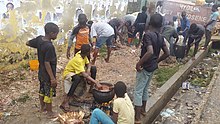Ìfọmọdé ṣiṣẹ́ ipá (Child Labour in Nigeria )
Ìfọmọdé ṣiṣẹ́ ipá ni a lè pè ní ọ̀nà ìlo ọgbọ́n ẹ̀wẹ́ láti lè jè kí àwọn ọmọdé ó má ní ànfaní sí ẹ̀tọ́ wọn gẹ́gẹ́ bí ọmọdé, tàbí ète láti lè jẹ́ kí wọ́n má ní ànfaní sí ẹ̀kọ́ nígbà èwe, èyí jẹ́ ohun búburú tí ó ń gbégidínà ẹ̀tọ́ àwọn ògo wẹẹrẹ. [1] Àwọn ìṣesí sí àwọn ọmọdé wọ̀nyí ni wọ́n ti di ohun àfòfindè jákè-jádò agbáyé[2] bí ó tilẹ̀ jẹ́ wípé àwọn òfin wọ̀nyí kò fẹsẹ̀ gbogbo iṣẹ́ tí a bá rán ọmọdé múlẹ̀ gẹ́gẹ́ bí ìfọmọdé ṣiṣẹ́ ipá; lára awọn ohun tí òfin kò kà kún àyàfi ni : ṣíṣe iṣẹ́-ilé, ṣíṣe iṣẹ́ àjùmọ̀ṣe inú ẹbí, ṣíṣe àbójútó ọmọdé nígbà tí eọ́n bá ń ṣeré ìdárayá, àti bẹ́ẹ̀ bẹ́ẹ̀ lọ.[3][4][5]



Ìfọmọdé ṣiṣẹ́ ipá ti wà láti ìgbà tó ti pẹ́, lásìkò ọ̀rùndú kọkàndínlógún sí ọ̀rùndún ogún sẹ́yìn, àwọn ọmọdé tí ọjọ́ orí wọn kò ju ọdún márùn ún sí mẹ́rìnlà tí wọ́n jẹ́ ọmọ tálákà ni wọ́n ń ṣiṣẹ́ ní àbẹ́ awọn ìlú amọ́nà Western Union. Ọ̀pọ̀ àwọn ọmọdé wọ̀nyí ni wọ́n ń ṣiṣẹ́ àgbẹ̀, iṣẹ́ ọmọ-ọ̀dọ̀, ilé-iṣẹ́, ibi ìwakùsà tabí kí wọ́n ṣiṣẹ́ gẹ́gẹ́ bí news boys, bákan náà ni àwọn kan ń ṣiṣẹ́ gbàáfúnmi-ngbàáfún ọ fún wákàtí méjìlá gbáko. Àmọ́ pẹ́lú ìgbésẹ̀ oríṣiríṣi láti ọwọ́ àwọn ajàfẹ́tọ́ ọmọnìyàn, àwọn Ìfọmọdé ṣiṣẹ́ ipá ti ń ròkun ìgbagbé. [6][7]
Ọ̀pọ̀ àwọn ìlú tí ebi àti ìṣẹ́ pọ̀ sí jùlọ ni ìwà ìfọmọdé ṣiṣẹ́ ipá pọ̀ sí jùlọ. Lára àwọn ilú bẹ́ẹ̀ ni a ti rí iye àwọn ọmọ tí wọ́n tó ìdá mọ́kàndínlọ́gbọ̀n (29) ní àwọn agbègbè bíi: sub-saharan Africa.[8] Ní ọdún 2017, àwọn orílẹ̀-èdè ilẹ̀ Adúláwọ̀ mẹ́rin yí: Mali, Benin, Chad àti Guinea-Bissau ni ìwádí tí àjọ UNICEF ṣe agbéjáde rẹ̀ fi hàn wípé àwọn ọmọdé tí ó tó ìdá àádọ́ta tí ọjọ́ orí wọn kò ju márùn ún sí mẹ́rìnlá lọ ni wọ́n kópa nínú ìfọmọdé ṣiṣẹ́ ipá.[8] Worldwide agriculture is the largest employer of child labour.[9] The vast majority of child labour is found in rural settings and informal urban economies; children are predominantly employed by their parents, rather than factories. Poverty and lack of schools are considered the primary cause of child labour.
Ìtàn
àtúnṣeÌfọmọdé ṣiṣẹ́ ipá ṣáájú ìrúgọ́gọ́ ilé-iṣẹ́ ní àwùjọ wa
àtúnṣeÌfọmọdé ṣiṣẹ́ ipá fúnra rẹ̀ ṣáájú ìrúgọ́gọ́ ilé-iṣẹ́ jẹ́ ohun tó farahàn ní àwùjọ.[10][11] Ìfọmọdé ṣiṣẹ́ ipá sábà ma ń bẹ̀rẹ̀ nígbà tí àwọn ọmọdé bá ti mọ ọ̀tún yàtọ̀ sí òsì, ó lè jẹ́ nípa kí wọ́n kópa nínú iṣẹ́ oko ṣíṣe, iṣẹ́ ọdẹ ati bẹ́ẹ̀ bẹ́ẹ̀ lọ. Ní ọ̀pọ̀ àwùjọ wọ́n ma ń rí awọn ọmọdé gẹ́gẹ́ bí àgbàlagbà ní kété tí wọ́n bá ti pé ọmọ ọdún mẹ́talá. [11]
-
Child labourers, Macon, Georgia, 1909
-
Children working in home-based assembly operations in United States (1923).
-
Two girls protesting child labour (by calling it child slavery) in the 1909 New York City Labor Day parade.
-
Arthur Rothstein, Child Labor, Cranberry Bog, 1939. Brooklyn Museum
Àwọn ìtọ́kasí
àtúnṣe- ↑ "What is child labour?". International Labour Organization. 2012.
- ↑ "International and national legislation - Child Labour". International Labour Organization. 2011.
- ↑ "Labour laws - An Amish exception". The Economist. 5 February 2004. http://www.economist.com/node/2413745.
- ↑ Larsen, P.B.. Indigenous and tribal children: assessing child labour and education challenges.. International Programme on the Elimination of Child Labour (IPEC), International Labour Office..
- ↑ "Council Directive 94/33/EC of 22 June 1994 on child labour". EUR-Lex. 2008.
- ↑ Cunningham and Viazzo (1996). Child Labour in Historical Perspective: 1800-1985. UNICEF. ISBN 978-88-85401-27-3. http://www.unicef-irc.org/publications/pdf/hisper_childlabour_low.pdf.
- ↑ Hindman, Hugh (2009). The World of Child Labour. M.E. Sharpe. ISBN 978-0-7656-1707-1.
- ↑ 8.0 8.1 "UNICEF Data – Child Labour". UNICEF. 2017. Retrieved 18 April 2018.
- ↑ "Child Labour". The Economist. 20 December 2005. http://www.economist.com/node/5328365?zid=317&ah=8a47fc455a44945580198768fad0fa41.
- ↑ Thompson
- ↑ 11.0 11.1 Diamond, J., The World Before Yesterday